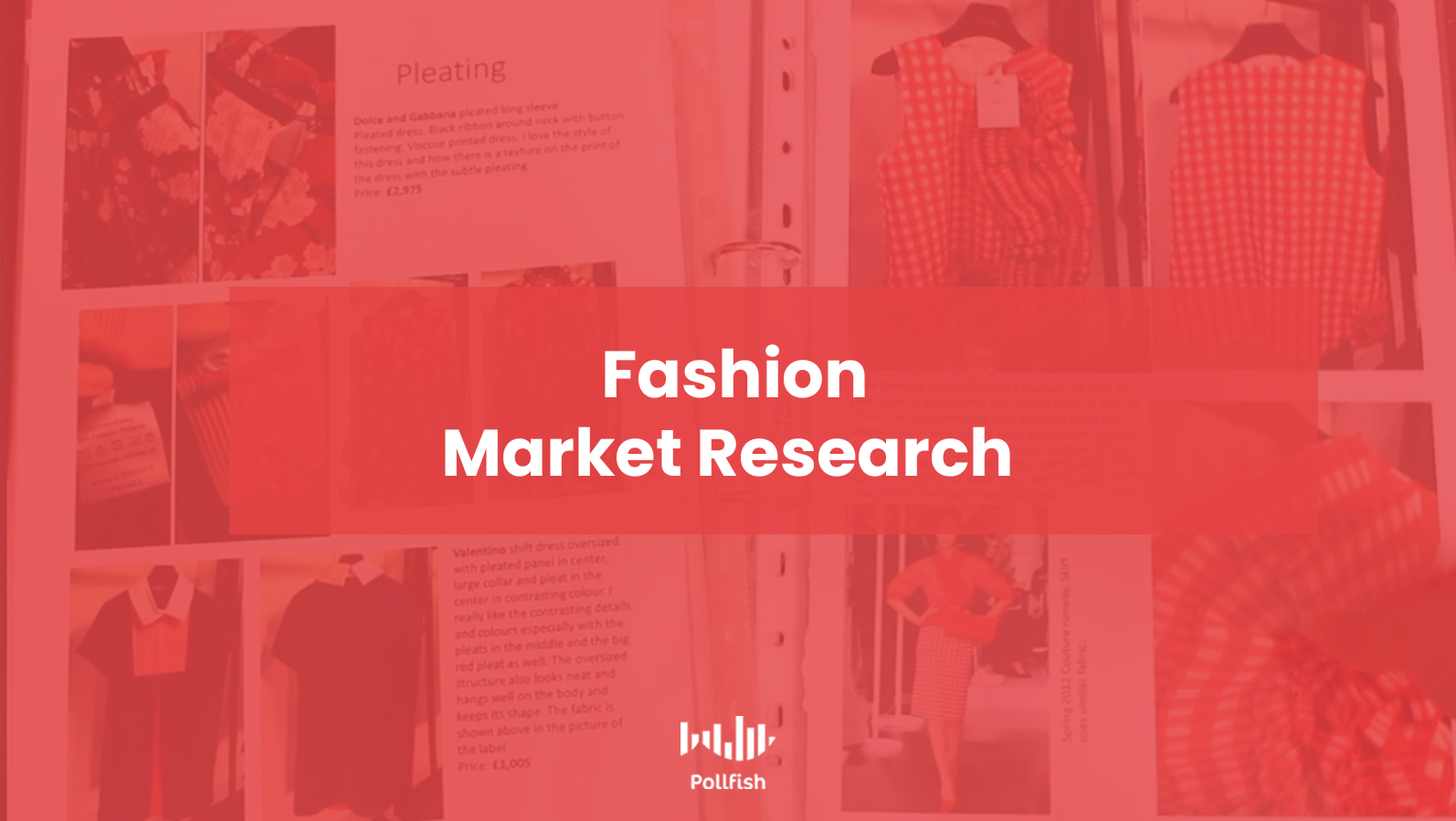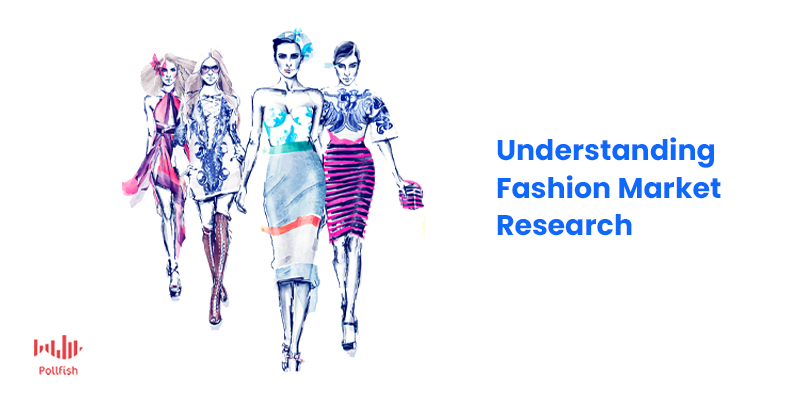How to Conduct Fashion Market Research Like a Pro

Fashion market research provides business owners and entrepreneurs with valuable insights so they can make confident, informed decisions to guide the development or evolution of their fashion business.
Valued at an impressive 1.5 trillion U.S. dollars in 2020, the global fashion/apparel industry is a behemoth industry covering a wide variety of garments and accessories.
While this sector has traditionally experienced consistent growth, the past year has been turbulent and challenging. Whether you are considering a new fashion venture or are looking for innovative ways to recover from an unprecedented year, market research is an effective way to guide your efforts.
This article covers how to conduct a combination of primary and secondary research o to power your fashion market research campaign.
Fashion Market Research Overview
Fashion market research is the process of gathering and analyzing information to gain insights into the fashion industry, which includes its top players, your competitors and mainly, your target market. Whether you own an existing apparel business or are considering an entry into the world of fashion, market research can ensure effective use of your marketing expenditure and increase the likelihood of business success.

Fashion market research is used to achieve the following:
- Understand how customers relate to your brand or a competitor’s brand.
- Identify areas for growth, new markets, and customer segments.
- Understand how existing customers would like to see your brand evolve.
- Gain insight into consumer spending when it comes to fashion needs and wants.
- Collect information about consumer opinions and interactions with various fashion segments (e.g. fast fashion vs. luxury brands).
- Understand how fashion marketing campaigns influence consumers’ opinions and behavior.
Undertaking a market research campaign project can provide you with the confidence you need to succeed in a highly competitive industry. The end-goal of fashion market research is to gain sufficient information to make informed decisions about your business so that it can thrive.
The Makeup of Fashion Market Research
Fashion market research is made up of two sources of information, referred to as primary and secondary research. By using both primary and secondary sources of information, you can determine several key factors about your target market and its various segments. These include:
- Annual spend on fashion in your niche
- A comparison of shopping experience frequencies, in-store vs. online
- Wardrobe share of certain brands and/or apparel categories
- Where and how your target market discovers your brand
- Shopping triggers
- Spending forecasts
- Marketing channels
- Product diversity
- How in-demand your products or brand are
To reap the most insights, you should plan to incorporate both primary and secondary sources to drive your fashion market research towards success.
Primary Research for the Fashion Industry
Primary market research refers to the unique data that is gathered from first-hand sources. While it is more labor-intensive to gather primary information, you are rewarded with data that is particularly relevant to your particular business and customer base. It also puts you in control in terms of the data you collect and then leverage.
The most valuable sources of primary information for fashion market research are:
- Online survey tools about existing or prospective customers, i.e., those in your target market that have not yet bought from you.
- Phone, in-person, and mall intercept interviews
- Focus groups:
- In contrast to one-on-one interviews, a focus group allows for moderated discussion among participants. This provides the opportunity for the group to share ideas and discuss a topic or trend, which is particularly useful when conducting fashion market
- Field research:
- This gives marketers an opportunity to observe and understand how customers behave in a natural setting. When it comes to fashion market research, field research provides valuable information about how customers browse and shop, both in-store (through natural observation) and online (via session replay tools).
- User testing:
- Often used to test out new design concepts, user testing gauges customer interest and reception. It is also used to test out in-store shopping experiences and changes to fashion websites.
Secondary Research for the Fashion Industry
Secondary research is performed by sourcing data from existing, published sources, i.e., data that you don’t need to amass yourself, as it has already been conducted. You should then parse through and organize the secondary data to prepare it for analysis. A strong analysis involves comparing the secondary resources against each other, along with their primary source counterparts.
Good sources of secondary information for the fashion industry include:
- Market and industry research reports and white papers
- Fashion industry websites
- SEO, keyword, and trends research
- Governments statistics
- Your competitors’ websites and other digital properties such as apps, mobile sites, ads, etc.
Secondary Research Sources for Fashion Market Research
To give your fashion market research a jumpstart, we have gathered some of the most relevant sources of secondary information for the fashion industry.

- Marketresearch.com Market Research Reports & Industry Analysis: A veritable font of information about the fashion and apparel industry, this site lets you search and filter to find general industry reports and more specific reports that pertain to your niche or sub-sector.
- McKinsey’s State of Fashion Annual Report: A trusted global consulting group, McKinsey publishes a free annual report on the fashion industry that contains insights on the global economy, consumer spending and behavior and the fashion industry as a whole. The recently published report on fashion in 2021 pays special attention to the impact that COVID-19 has had and will continue to have on the industry in the coming year.
- Statista.com Global Apparel Market – Statistics and Facts: Statista offers a wealth of information and statistics on the fashion market. You can access a variety of charts and reports for free, or purchase more comprehensive reports, such as Apparel Market Worldwide dossier.
- NPD Fashion Trend Tracker: The global consulting group NPD has created a subscription-based trend tracker that provides the latest information on changing fashion trends. Use this to track change and identify areas of growth in your vertical.
- NPD website: In addition to paid sources of information, the NPD Group is also an excellent source of free information about the fashion and apparel industry, published as articles and blog posts on their website.
- The Business of Fashion: This online magazine collates insights gathered by journalists in over 125 countries. Subscription-based memberships are available for those who want to gain insights from a leading source of fashion industry news and information.
- KPMG Sustainable Fashion report: Published by KPMG, this free report focuses on consumer perception of sustainable fashion. The group interviewed over 1,000 individuals in the world’s largest cities to understand how consumers relate to sustainable fashion and responsible buying behavior.
- CommonObjective.co: For anyone with an eye on sustainability as it pertains to fashion, Common Objective is a valuable source of both free and paid information about trends, sourcing, marketing, consumer behavior, and more.
Confront New Challenges with Market Research
Fashion businesses have more challenges to consider than ever before. If your business is struggling to recover from the global pandemic, market research can help you identify new areas of growth. With a tightened budget, market research is vital to ensure your marketing and advertising spend is used wisely.
Or perhaps you are looking to evolve your business in response to the concerns of “woke” consumers, who demand a higher level of environment and social responsibility from fashion brands. Market research can help you meet these demands and shape your targeted messaging.
Even without new challenges, every fashion business fights the constant battle to remain relevant and stylish in an ever-changing landscape. Consumers on the hunt for something unique and new will continue to push fashion brands to evolve their style to satisfy their customers’ demands.
Fortunately, this demand comes with more direct access to your customers via social media. You can benefit from an engaged audience by regularly deploying online surveys to gather insights about their needs and desires, no matter how often they change.
Regardless of your motivations, fashion market research can provide you with valuable insights to help you make confident decisions in the months and years to come.
Frequently asked questions
What is fashion market research?
Fashion market research involves collecting and analyzing data in order to gain a better understanding of how an apparel business is positioned in the competitive landscape.
Who can benefit from fashion market research?
Fashion market research is beneficial for a wide variety of businesses that operate within the fashion industry. This includes established brands, fashion startups, brick-and-mortar stores, apparel chains, and artisan fashion producers.
What are some of the reasons for conducting fashion market research?
Fashion market research can help a business identify new target markets, understand how existing customers feel about their brand, gain insights into fashion spending, and explore how marketing campaigns can affect buying behavior.
How is fashion market research conducted?
After identifying the goals of the fashion market research project, the team will conduct primary and secondary research to gather information from the appropriate sources. Then, this information will be compiled into a report that contains findings and recommendations.
What types of primary research are most appropriate for fashion market research?
The most useful types of primary research for the fashion industry include surveys, interviews, focus groups, field research, mall intercepts, and user testing.
Pollfish Marketing Team
Ready to Try Pollfish?
Create your survey with AI, target high-quality respondents starting at $0.95 per complete, and start getting results in just minutes in real-time. From running a simple product concept survey to managing a constant stream of trackers for dozens of clients in dozens of countries, we’ve got you.
